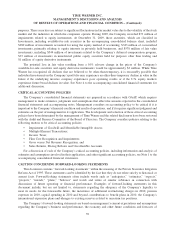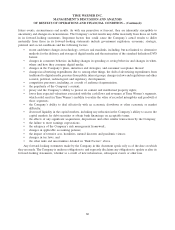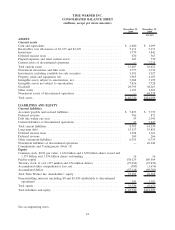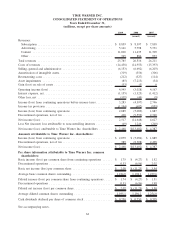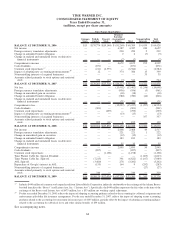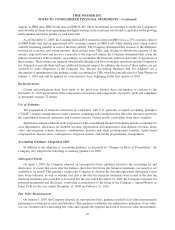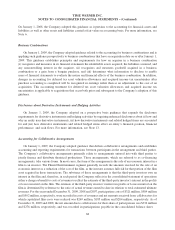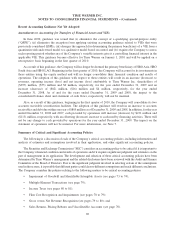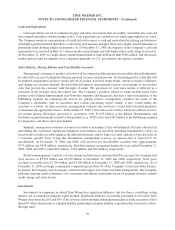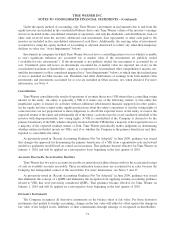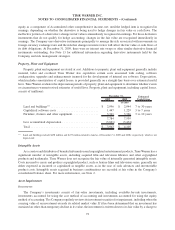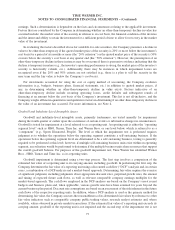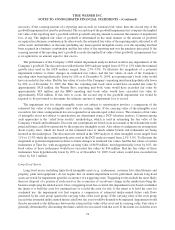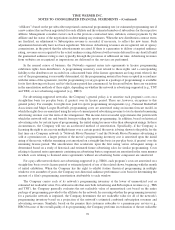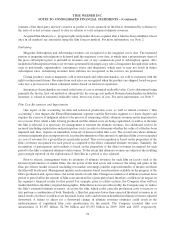Time Magazine 2009 Annual Report Download - page 80
Download and view the complete annual report
Please find page 80 of the 2009 Time Magazine annual report below. You can navigate through the pages in the report by either clicking on the pages listed below, or by using the keyword search tool below to find specific information within the annual report.On January 1, 2008, the Company adopted this guidance as it pertains to the accounting for financial assets and
liabilities as well as other assets and liabilities carried at fair value on a recurring basis. For more information, see
Note 6.
Business Combinations
On January 1, 2009, the Company adopted guidance related to the accounting for business combinations and is
applying such guidance prospectively to business combinations that have an acquisition date on or after January 1,
2009. This guidance establishes principles and requirements for how an acquirer in a business combination
(i) recognizes and measures in its financial statements the identifiable assets acquired, the liabilities assumed, and
any noncontrolling interest in the acquiree, (ii) recognizes and measures goodwill acquired in a business
combination or a gain from a bargain purchase, and (iii) determines what information to disclose to enable
users of financial statements to evaluate the nature and financial effects of the business combination. In addition,
changes in accounting for deferred tax asset valuation allowances and acquired income tax uncertainties after
purchase accounting is completed will be recognized in earnings rather than as an adjustment to the cost of an
acquisition. This accounting treatment for deferred tax asset valuation allowances and acquired income tax
uncertainties is applicable to acquisitions that occur both prior and subsequent to the Company’s adoption of this
guidance.
Disclosures about Derivative Instruments and Hedging Activities
On January 1, 2009, the Company adopted on a prospective basis guidance that expands the disclosure
requirements for derivative instruments and hedging activities by requiring enhanced disclosures about (i) how and
why an entity uses derivative instruments, (ii) how derivative instruments and related hedged items are accounted
for and (iii) how derivative instruments and related hedged items affect an entity’s financial position, financial
performance, and cash flows. For more information, see Note 13.
Accounting for Collaborative Arrangements
On January 1, 2009, the Company adopted guidance that defines collaborative arrangements and establishes
accounting and reporting requirements for transactions between participants in the arrangement and third parties.
The Company’s collaborative arrangements primarily relate to arrangements entered into with third parties to
jointly finance and distribute theatrical productions. These arrangements, which are referred to as co-financing
arrangements, take various forms. In most cases, the form of the arrangement is the sale of an economic interest in a
film to an investor. The Filmed Entertainment segment generally records the amounts received for the sale of an
economic interest as a reduction of the cost of the film, as the investor assumes full risk for that portion of the film
asset acquired in these transactions. The substance of these arrangements is that the third-party investors own an
interest in the film and, therefore, in each period the Company reflects in the consolidated statement of operations
either a charge or benefit to costs of revenues to reflect the estimate of the third-party investor’s interest in the profits
or losses incurred on the film. The estimate of the third-party investor’s interest in profits or losses incurred on the
film is determined by reference to the ratio of actual revenue earned to date in relation to total estimated ultimate
revenues. For the years ended December 31, 2009, 2008 and 2007, participation costs of $321 million, $584 million
and $502 million, respectively, were recorded in costs of revenues and net amounts received from collaborators for
which capitalized film costs were reduced was $269 million, $185 million and $284 million, respectively. As of
December 31, 2009 and 2008, the net amount due to collaborators for their share of participations was $332 million
and $276 million, respectively, and was recorded in participations payable in the consolidated balance sheet.
68
TIME WARNER INC.
NOTES TO CONSOLIDATED FINANCIAL STATEMENTS – (Continued)



